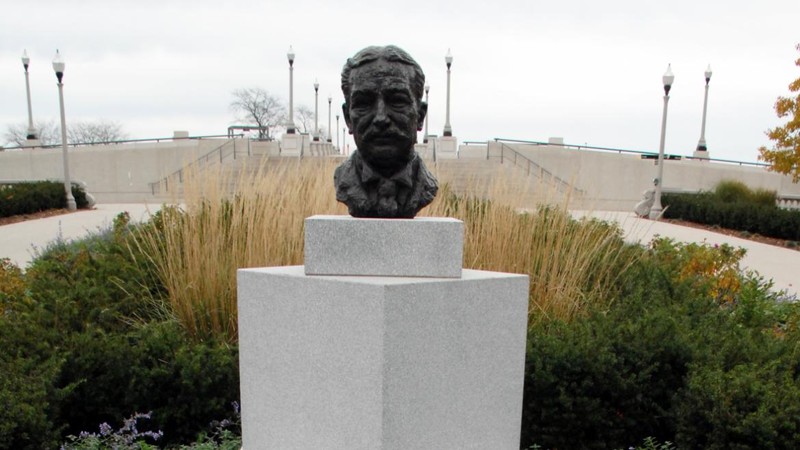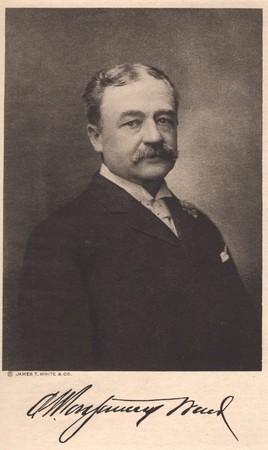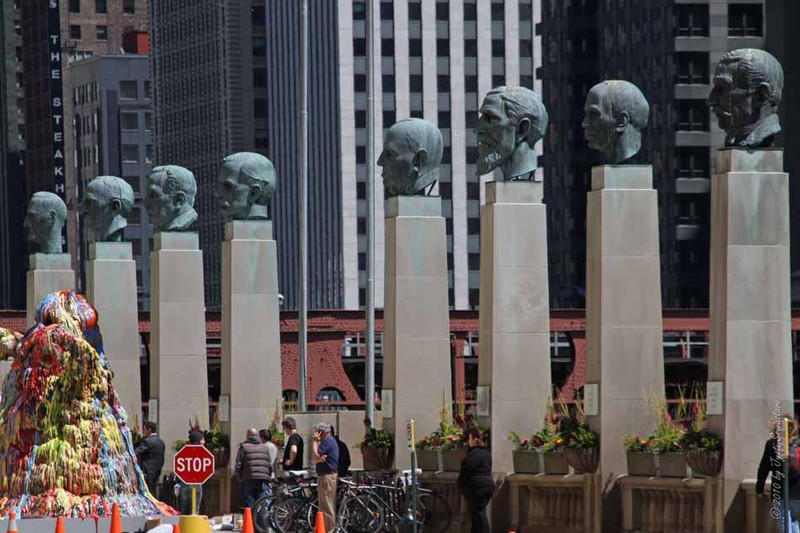Aaron Montgomery Ward Bust
Introduction
Text-to-speech Audio
Images
Aaron Montgomery Ward Bust in Chicago's Grant Park

Aaron Montgomery Ward (1844-1913)

Horn's original bronze bust of Ward (last on the right) at the Merchandise Mart Hall of Fame in Chicago

Backstory and Context
Text-to-speech Audio
Aaron Montgomery Ward was born into a large family on February 17, 1844 in Chatham, New Jersey. While he was still a boy, his father moved the family to Niles, Michigan. Ward attended public schools until the age of fourteen, when he began working a series of odd jobs to support the family. Later, he moved to the town of St. Joseph, Michigan, where he found work as a clerk in a general store. In only three years, Ward became the store’s manager.
In 1865, Ward moved to Chicago. There, he worked first as a clerk in a general store and then as an itinerant salesman. While traveling across the Midwest on business in the late 1860s, Ward became acquainted with the region’s farmers, who resented middlemen who drove up the prices of retail goods. He also observed that railroads were increasingly connecting rural areas to major urban centers. Seeing a business opportunity, Ward started a mail-order company that purchased dry goods at wholesale prices and then sold them directly to consumers at a low markup. The company’s first catalog, issued in 1872, was a one-page list of roughly 150 items. Three years later, Ward introduced another novel concept, the money-back guarantee. Despite selling at low margins, Montgomery Ward & Company steadily grew. By 1886, its catalog was 240 pages in length and contained approximately 10,000 items. Annual sales reached $1 million by 1888 and soared to $40 million by 1913.
During the final decades of his life, Ward stepped away from the day-to-day operations of the company and refocused his energies elsewhere. In 1886, he turned management of the company over to his brother-in-law, George Thorne, who purchased a half interest in the business back in 1873 for $500. In 1890, Ward embarked on a grueling personal crusade to prevent the City of Chicago and private interests from developing the portion of Chicago’s lakefront that is now Grant Park (known as Lake Park before 1901). While many Chicagoans hoped to see civic buildings and museums constructed along the city’s lakefront, Ward, on the other hand, desired to preserve the park and thus the area’s open, relatively undeveloped state. Despite intense public criticism, which damaged his popularity, and multiple lawsuits, which cost him copious amounts of his own money, he persevered and in 1910 the Illinois Supreme Court ruled in his favor. Three years later, Ward died at the age of sixty-nine.
Four decades after Ward’s death, Joseph Kennedy, patriarch of the famous American political family, commissioned eight, four-times-life-sized bronze busts of famous American merchants. The artworks came to comprise the Merchandise Mart Hall of Fame in Chicago. Hired to create the busts of Frank Winfield Woolworth and Aaron Montgomery Ward was Russian-American sculptor Milton Horn. In either the late 1980s or the early 1990s, Montgomery Ward & Company commissioned Horn to recreate his original bronze bust of the company founder, but on a much smaller scale. With the help of the Montgomery Ward Foundation and the Friends of the Parks, the bust was installed in Grant Park in 1993. Six years later, it was moved from its original location to make way for the construction of Millennial Park. In 2005, the bust was placed in its current location in Grant Park.
Sources
"Aaron Montgomery Ward Bust." Chicago Park District. City of Chicago. Web. 16 March 2021 <https://www.chicagoparkdistrict.com/parks-facilities/aaron-montgomery-ward-bust>.
Hendrickson, Kenneth E., ed. The Encyclopedia of the Industrial Revolution in World History. Lanham, MD: Rowman & Littlefield, 2015.
Lienhard, John H. "No. 1641: Aaron Montgomery Ward." Engines of Our Ingenuity. University of Houston College of Engineering. Web. 16 March 2021 <https://uh.edu/engines/epi1641.htm>.
"Montgomery Ward." Encyclopædia Britannica. Web. 16 March 2021 <https://www.britannica.com/biography/Montgomery-Ward>.
Witzel, Morgen, ed. Encyclopedia of the History of American Management. Bristol: Thoemmes Continuum, 2005.
https://www.chicagoparkdistrict.com/media/grant-park-aaron-montgomery-ward-bust
https://uh.edu/engines/epi1641.htm
http://chicago-outdoor-sculptures.blogspot.com/2007/11/merchandise-mart-hall-of-fame.html
